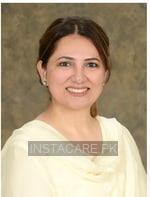Pneumonia - Symptoms, Risk factors and Treatment
Last Updated On Sunday, July 6, 2025
Pneumonia in Urdu
نمونیا ایک یا دونوں پھیپھڑوں کا انفیکشن ہے۔ یہ وائرس، بیکٹیریا یا فنگی کی وجہ سے ہوسکتا ہے۔ آپ کے پھیپھڑے پیپ اور سیال سے بھر جاتے ہیں جو الیوولی کی سوزش کا سبب بنتا ہے، آخر کار سانس لینے میں دشواری کا باعث بنتا ہے۔ نمونیا کا صحیح وقت پر علاج کیا جانا چاہیے۔ اگر علاج نہ کیا جائے تو یہ جان لیوا بن سکتا ہے۔ یہ مختلف وجوہات کی وجہ سے ہوسکتا ہے، عام طور پر سرد ماحول کی نمائش کی وجہ سے۔
Pneumonia in English
Pneumonia is the infection of one or both lungs. It can occur due to viruses, bacteria, or fungi. Your lungs fill with pus and fluid that causes inflammation of the alveoli, eventually causing breathing difficulty. Pneumonia should be treated at the right time. If left untreated, it can become life-threatening. It can occur due to various causes, commonly due to exposure to a cold environment.
What are the Signs and Symptoms of Pneumonia?
Pneumonia can show the following signs and symptoms;
- Cough
- Shortness of breath
- Chest pain (during breathing or coughing)
- Sweating or chills
- Nausea and vomiting
- Headache
- Green phlegm
- Fever
- Difficulty in breathing
- Loss of appetite
What are the Causes of Pneumonia?
Pneumonia occurs due to viruses, fungi, and bacteria. Germs are present around you. They can enter your body through your nose and mouth and finally reside in the lungs, causing infection.
Respiratory infections spread from person to person through airborne droplets. If an infected person coughs and sneezes in a close environment in front of others, the other people will eventually catch the infection. The germs can also transmit through high-touch surfaces. If an infected person is carrying viruses on his hand and touches the surface, he will transmit the virus on the surface. If a healthy person touches that surface again, he can catch the virus easily.
You can protect yourself from respiratory tract infections by wearing a mask if you are coughing or sneezing. Wash your hands frequently and sanitize them with an alcohol-based sanitizer. Do not touch your face, nose, and eyes with unwashed hands.
Keep disinfecting the high-touch surfaces like switchboards, doorknobs, fridge doors, and keys, etc. Avoid going to overcrowd places and maintain a distance of 6 feet from the one who is coughing or sneezing.
What are the Types of Pneumonia?
Pneumonia, based on the cause can be classified as;
- Community-acquired pneumonia
- Hospital-acquired pneumonia
- Health care-acquired pneumonia
- Aspiration pneumonia
Community-acquired pneumonia
Pneumonia that is acquired from outside of the hospital is known as community-acquired pneumonia. The most common cause of community-acquired pneumonia is Streptococcus Pneumoniae. However other viruses, bacteria, and fungi can also play a role. Nowadays, coronavirus has also become a big source of community-acquired pneumonia.
Hospital-acquired pneumonia
Hospital-acquired pneumonia is the one that patients catch during their hospital stay. It is the second most acquired disease from hospitals. Hospital-acquired pneumonia is more difficult to treat as compared to others because;
The patient may also be already immunocompromised
The causative strain can be mutant or already resistant to various antibiotics
Health care-acquired pneumonia
Health care-acquired pneumonia is caused mostly by bacteria. It occurs when a person lives in a healthcare facility for a long time or visits time and again like for kidney dialysis. Like hospital-acquired pneumonia, healthcare-acquired pneumonia is also difficult to treat as compared to others because;
The patient may also be already immunocompromised
The causative strain can be mutant or already resistant to various antibiotics
Aspiration pneumonia
Aspiration pneumonia occurs when a person inhales something. It can be saliva, vomit, or any food. Aspiration is more likely to occur if the person has any brain damage, swallowing difficulty, excessive use of drugs or alcohol.
Conclusion
Pneumonia is the infection of one or both lungs. It can occur due to viruses, bacteria, or fungi. To prevent it, you can wear masks when in contact with an infected person. The doctors generally prescribe antibiotics and anti-inflammatory drugs to get rid of it. Moreover, you should avoid expsoure to cold environments to prevent it. If you have any symptoms of pneumonia, you should visit the healthcare provider soon.
Frequently Asked Questions
Pneumonia Meaning in Urdu is نمونیا.
The real meaning of pneumonia is an infection of the lungs. It causes the air sacs of the lungs to fill up with fluid or pus, making it difficult to breathe. It can range from mild to severe, depending on the type of germ causing the infection, your age, and your overall health.
The four main symptoms of pneumonia are chest pain, fever, difficulty breathing, and coughing with phlegm or pus. Other symptoms may include fatigue, shortness of breath, chills, sweating, nausea, vomiting, and diarrhea. In newborns and infants, symptoms may include vomiting, fever, and difficulty breathing and eating.
Many germs can cause pneumonia, including bacteria, viruses, and fungi. The most common causes of bacterial pneumonia in the U.S. are Streptococcus pneumoniae and Mycoplasma pneumoniae. Viruses, like coronavirus 2019 (COVID-19), can also cause pneumonia. Other causes include aspiration pneumonia (inhaling food, drink, vomit, or saliva), and hospital-acquired or health care-acquired pneumonia.









